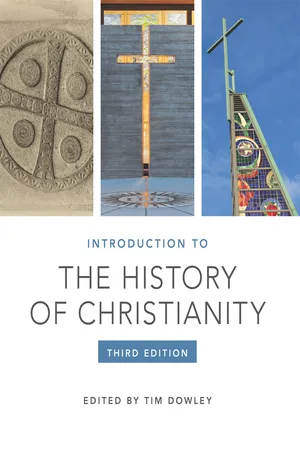
- 620 pages
- English
- ePUB (mobile friendly)
- Available on iOS & Android
About this book
Now in its third edition, Tim Dowley's masterful one-volume survey of church history has an updated design and new content, particularly in the section covering most recent Christian history. The inviting full-color format includes many new images and updated maps, while maintaining many of the features that made the second edition a popular volume for the classroom.
Dowley has assembled a global cast of respected scholars to write the full story of the rise of the Christian faith and to provide a rounded picture of the worldwide development of Christianity. The volume has been praised as accurate, scholarly, and balanced. Its writers are committed to Christianity but also to the unhindered pursuit of truth that does not avoid the darker aspects of the varied story of Christianity.
The accessible text is supported by detailed timelines, maps, profiles of key figures in Christianity, colorful images, and a complete glossary. Each section includes questions for discussion.
Frequently asked questions
- Essential is ideal for learners and professionals who enjoy exploring a wide range of subjects. Access the Essential Library with 800,000+ trusted titles and best-sellers across business, personal growth, and the humanities. Includes unlimited reading time and Standard Read Aloud voice.
- Complete: Perfect for advanced learners and researchers needing full, unrestricted access. Unlock 1.4M+ books across hundreds of subjects, including academic and specialized titles. The Complete Plan also includes advanced features like Premium Read Aloud and Research Assistant.
Please note we cannot support devices running on iOS 13 and Android 7 or earlier. Learn more about using the app.
Information
I
BEGINNINGS: AD 1–325
SUMMARY
1
Jesus: His Life, Ministry, Death, and Its Consequences
DID JESUS OF NAZARETH EXIST?

WHAT ARE THE MAIN SOURCES?

WHERE DID JESUS COME FROM?
| THE THOUGHT-WORLD OF EARLY CHRISTIANITY Twenty-first century students are familiar with terms such as cultural diversity and globalization. Christianity was born in a cultural setting that experienced its own forms of intellectual and religious diversity, brought into conversation with each other thanks to the global expansion of the Roman Empire. The Gospel of Luke and the Acts of the Apostles display the three distinctive threads in this tapestry: Jewish, Greek, and Roman. Jesus was born into a world of pious Jews, devoted to their traditions and to the Jerusalem Temple. At the same time, many first-century Jews imagined a day when God would raise up a new anointed one (messiah) to right the wrongs of injustice and liberate Israel from foreign rule. They found the religious vocabulary for these hopes in passages from the Hebrew prophets, especially Isaiah, Jeremiah, Ezekiel, and Daniel. So Luke’s Gospel has the adult Jesus begin his public career by announcing that God’s Spirit now rests on him. The time of fulfilment is at hand (Luke 4:14–21). Though Jesus, himself, would have known those scriptures in Hebrew, and their translations into the Aramaic spoken in Palestine, Luke and the other New Testament authors employ the Greek translations used by diaspora Jews since the third century bc. Called ‘the Septuagint’ (LXX), these Greek versions sometimes create new meanings for Greek words to translate Hebrew concepts, or substitute a familiar Greek concept for the Hebrew. For example, the Greek word diathe-ke- ordinarily means a will or testament, but in the LXX it translates the Hebrew berîth, ‘covenant’. Alexander the Great’s Eastern conquests in the fourth century bc had spread Greek language, civic organization, and culture throughout the region. Attempts by his successors to create a thoroughly ‘Greek city-state’ and religious culture in Jerusalem resulted in persecution and rebellion in the mid-first century bc (1 Maccabees 1:1–15). Important religious concepts emerge among Jews opposed to the world being created by Alexander’s successors, illustrated in Danie... |
Table of contents
- Cover
- Title Page
- Copyright
- Table Of Contents
- Contributors
- List of Maps
- List of Time Charts
- List of Illustrations
- Preface
- Preface to the Revised Edition
- Preface to the Third Edition
- BEGINNINGS: AD 1–325
- ACCEPTANCE AND CONQUEST: AD 325–600
- A CHRISTIAN SOCIETY: AD 600–1500
- REFORM AND RENEWAL: 1500–1650
- REASON, REVIVAL, AND REVOLUTION: 1650–1789
- CITIES AND EMPIRES: 1789–1914
- A CENTURY OF CONFLICT: 1914–2001
- EPILOGUE: A NEW MILLENNIUM
- Further Resources on the History of Christianity
- Glossary
- Index
- Picture Acknowledgments